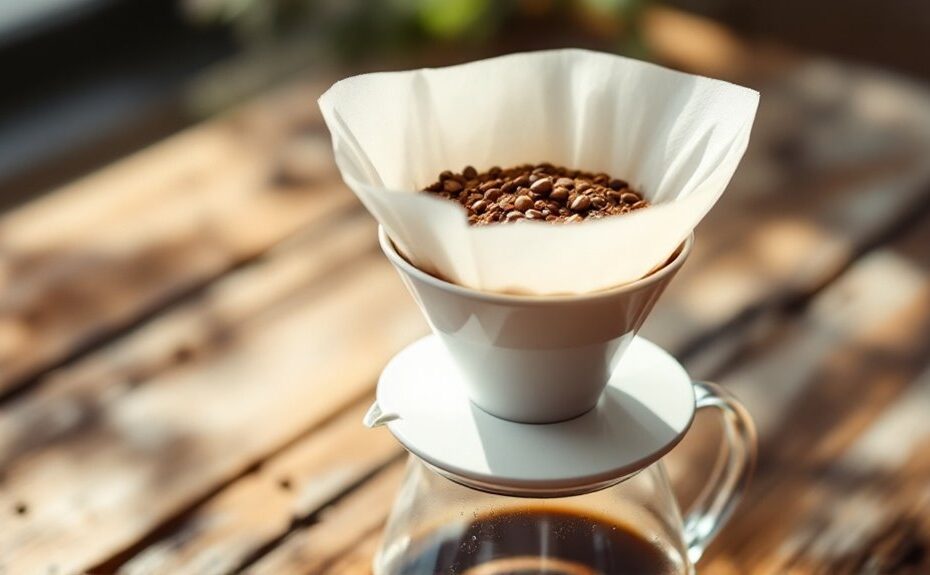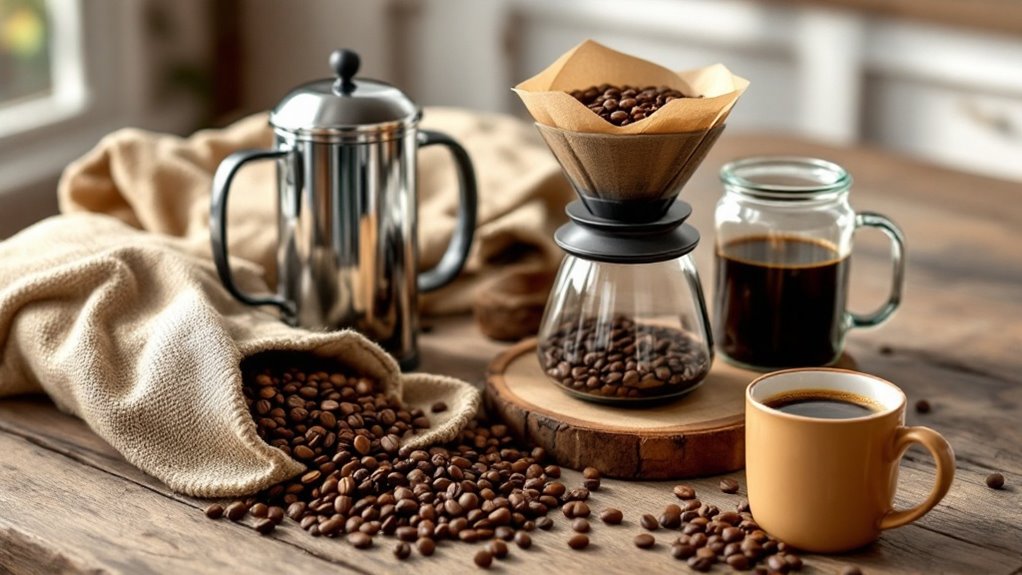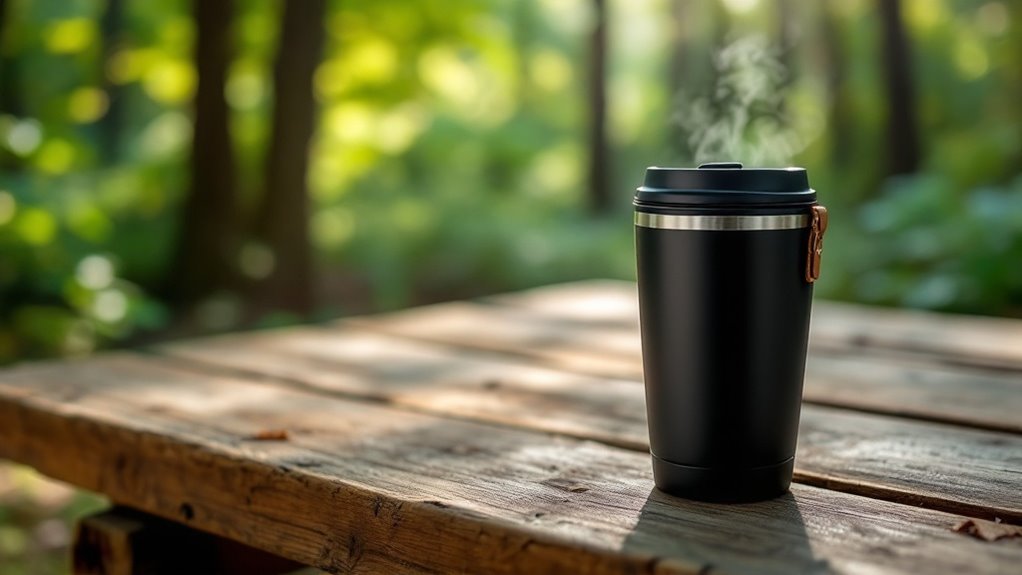







Choosing the best coffee filter for your brew method isn't just about convenience—it's about revealing the full potential of your coffee. Paper filters might give you a clean cup, but metal or cloth options can add depth and richness to your brew. The shape and material of your filter can drastically alter the flavor profile, and not all filters work seamlessly with every brewing method. So, how do you decide which one suits your setup and taste preferences? The answer lies in understanding the nuances of each filter type and how they interact with your chosen brewing technique.
Key Takeaways
- Hario V60: Use conical filters (paper, metal, or cloth) for even extraction and a rich, concentrated brew.
- Kalita Wave: Opt for flat-bottom filters to ensure balanced flavor and consistent extraction.
- Chemex: Requires proprietary thick, conical paper filters for a clean, slow-brewed cup.
- Aeropress: Choose disc filters (paper, metal, or cloth) for quick, sediment-free brewing.
- French Press: No additional filter needed; its built-in metal mesh filter suffices for a robust, full-bodied brew.
Types of Coffee Filter Materials
When choosing a coffee filter, the material plays a key role in shaping your brew's flavor and texture. Paper filters are the most common, offering a clean, bright cup by trapping coffee oils and fine sediment. They're disposable, biodegradable, and ideal for those who prefer a lighter flavor profile. Metal filters, on the other hand, are reusable coffee filters made from stainless steel or gold-tone mesh. They allow more coffee oils to pass through, resulting in a richer, fuller-bodied brew. However, they require thorough cleaning to avoid sediment buildup or metallic aftertastes. Cloth filters, typically made from cotton, hemp, or nylon, are also reusable and excel at trapping fine grounds while letting oils enhance the flavor profile. They produce a full-bodied cup but demand meticulous care—proper cleaning and drying are essential to prevent mold or bacteria. Each material impacts your coffee's flavor profile differently: paper filters emphasize clarity, while metal and cloth filters highlight richness. Consider your brew preferences and maintenance tolerance when selecting between paper filters, metal filters, or cloth filters.
Paper Filters: Bleached vs. Unbleached
Choosing between bleached and unbleached paper filters can substantially impact your coffee's flavor and brewing experience. Bleached paper filters undergo a bleaching process, typically using oxygen, to achieve a uniform white color and consistent porosity. This guarantees they effectively trap coffee oils and sediment, resulting in a cleaner cup. Unbleached paper filters, which retain their natural brown color, allow more oils and flavors to pass through, often producing a fuller-bodied brew. However, unbleached filters may introduce a slight papery taste, which you can minimize by pre-rinsing them with hot water before brewing. Both white and brown filters are disposable, but bleached options are often preferred for their neutral flavor profile. While some worry about the bleaching process, modern methods are eco-friendly and safe, avoiding chlorine. If you prioritize clarity and a cleaner taste, opt for bleached paper filters. For a more robust, natural flavor, unbleached filters are ideal, provided you pre-rinse them to reduce any residual taste. Your choice ultimately depends on your preference for flavor balance and brewing convenience.
Metal Filters: Durability and Flavor
Metal filters, crafted from stainless steel or gold-tone mesh, offer a durable alternative to paper filters, lasting for years with proper maintenance. These reusable filters are eco-friendly, reducing waste and providing a sustainable option for your daily brew. Made from high-quality stainless steel, they allow more natural oils and fine coffee particles to pass through, enhancing your coffee flavor with a fuller-bodied and richer profile. However, this also means you'll need to pay attention to cleaning. Rinse your metal filter thoroughly after each use to prevent residue buildup, and occasionally deep clean it with a brush or mild detergent to maintain peak performance. Some users report a slight metallic taste in their coffee, but this can often be minimized by pre-rinsing the filter before brewing. If you prioritize durability, sustainability, and a robust coffee flavor, metal filters are an excellent choice. Just make sure you're prepared for the extra care they require to keep your brew tasting its best.
Cloth Filters: Sustainability and Maintenance
Cloth filters offer a sustainable and eco-friendly alternative to disposable paper filters, making them a popular choice for environmentally conscious coffee enthusiasts. These reusable cloth coffee filters, typically made from cotton, hemp, or nylon, can be used up to 100 times with proper care, greatly reducing waste. To maintain their performance and hygiene, you'll need to clean them thoroughly after each use. Rinse out coffee grounds immediately and wash the filter with hot water and a mild detergent to remove residual oils. For deeper cleaning, boil the filter in water for 5-10 minutes or freeze it overnight to eliminate bacteria and odors. Proper drying is essential—hang the filter in a well-ventilated area to prevent mold growth. Cloth filters allow more natural oils to pass through compared to paper filters, resulting in a fuller-bodied and richer coffee flavor. However, their maintenance requires diligence to guarantee durability and peak taste. With consistent cleaning and care, cloth coffee filters are a practical, eco-friendly option for enhancing your brew.
Coffee Filter Shapes and Their Uses
Flat-bottom filters, like those for Kalita Wave, guarantee even extraction and balanced flavor, making them ideal for larger brews. Cone-shaped filters, such as Hario V60 or Chemex, create a deeper coffee bed, slowing water flow for a more concentrated and full-bodied cup. Choosing the right filter shape depends on your brew method and desired extraction profile, so match the filter to your equipment and taste preferences.
Flat-Bottom Filter Benefits
When brewing coffee, the shape of your filter plays a pivotal role in extraction and flavor. Flat-bottom filters are designed with a larger surface area, which promotes even water distribution and consistent extraction. This results in a balanced flavor profile, making them ideal for drip coffee makers and flat-bottom pour-over devices like the Kalita Wave. Their design allows for a faster flow rate, reducing the risk of over-extraction and bitterness, which is particularly beneficial when brewing larger quantities. Flat-bottom filters are also beginner-friendly, as their uniform shape guarantees easier water flow and more predictable results, even for those new to manual brewing methods. If you're looking for a brewing method that delivers reliability and versatility, flat-bottom filters are a practical choice. They're compatible with a range of devices, offering flexibility whether you're using an automatic drip machine or a manual pour-over setup. For consistent, high-quality coffee, flat-bottom filters are a dependable option that balances efficiency and flavor.
Cone-Shaped Filter Advantages
Cone-shaped filters, with their steep, tapered design, create a deeper coffee bed that enhances extraction and produces a richer, more concentrated brew. This shape promotes a slower, controlled water flow, ensuring even saturation of the grounds and maximizing flavor extraction. The result is a full-bodied cup with pronounced clarity and brightness, ideal for those who appreciate nuanced coffee profiles. Cone-shaped filters are particularly well-suited for pour-over techniques, such as those used with the Hario V60, where precision in water distribution is key to achieving ideal results. Their design allows you to control brewing variables more effectively, making them a favorite among specialty coffee enthusiasts. Available in various sizes (e.g., #1, #2, #4, #6), cone-shaped filters accommodate different brewing quantities, ensuring versatility across devices like the Origami and Kinto drippers. When using these filters, focus on maintaining a consistent pour-over technique to fully leverage their advantages. Whether you're brewing a single cup or a larger batch, cone-shaped filters deliver a balanced, flavorful experience that highlights the best qualities of your coffee.
Choosing the Right Shape
Selecting the right coffee filter shape can substantially influence your brewing results, as each design impacts extraction, flow rate, and flavor profile. Cone-shaped filters, like those for Hario V60 or Chemex, are ideal for pour-over methods. Their tapered design promotes a slower, controlled flow rate, allowing for thorough extraction and a bright, nuanced flavor profile. Flat-bottom filters, such as Kalita Wave filters, offer a larger surface area, ensuring even extraction and a balanced flavor, making them suitable for drip coffee makers. Basket-shaped filters are commonly used in automatic drip machines, designed to handle larger quantities of coffee while maintaining consistent water flow for uniform brewing. Disc filters, found in Aeropress or Moka Pot setups, are flat and circular, enabling quick brewing times and easy cleanup, ideal for compact devices. Each filter shape directly affects brewing time and extraction rate, so choose based on your preferred method and desired flavor profile. For pour-over methods, opt for cone-shaped filters; for drip machines, flat-bottom or basket-shaped filters work best; and for quick, concentrated brews, disc filters are your go-to.
Flat-Bottom vs. Cone-Shaped Filters
Flat-bottom filters stand out for their ability to deliver even extraction across a larger surface area, making them a go-to choice for brewing larger batches of coffee. Their design creates a shallow coffee bed, which allows water to flow evenly through the grounds, enhancing balanced flavor and reducing the risk of over-extraction. This makes flat-bottom filters ideal for methods like drip coffee makers or batch brewers, where consistency and ease of use are key. On the other hand, cone-shaped filters create a deeper coffee bed, slowing the flow rate and promoting a more concentrated brew. This shape is perfect for smaller, single-cup methods like pour-over, where you want to highlight nuanced, full-bodied flavors. However, cone-shaped filters require careful attention to avoid overflow or uneven extraction. When choosing between filter shapes, consider your brewing process: flat-bottom filters excel in larger, consistent batches, while cone-shaped filters shine in crafting smaller, more intense cups. Both shapes influence extraction and flavor, so match your choice to your desired brew style.
Filter Compatibility by Brewing Method
When selecting a coffee filter, it's vital to pair it with your brewing technique to attain peak outcomes. Filter compatibility varies notably across brewing methods, and using the correct filter type guarantees proper extraction, flow rate, and flavor balance. For a Hario V60, you'll need conical filters—whether paper, metal, or cloth—to match its steep angle and promote even extraction. The Kalita Wave, on the other hand, requires flat-bottom filters to distribute water evenly across the coffee bed, enhancing flavor consistency. Chemex demands its proprietary thick, conical paper filters, which are indispensable for its slow, clean brew process. If you're using an Aeropress, opt for disc filters, available in paper, metal, or cloth, to achieve a sediment-free cup. French Press users don't need additional filters, as its built-in metal mesh disc handles filtration. Always consider your brewing method when choosing filter types—paper filters for clarity, metal for durability, or cloth for a balance of both. Matching your filter to your brewer guarantees you'll extract the best possible flavors from your coffee.
Environmental Impact of Coffee Filters
Paper filters are biodegradable but often bleached, raising concerns about chemical residues and landfill contributions. Metal filters, like stainless steel or mesh, offer long-term sustainability by being reusable and reducing waste. Cloth filters, made from cotton or hemp, are eco-friendly and reusable but require diligent cleaning to maintain hygiene and performance.
Paper Filters: Biodegradability Concerns
How often do you consider the environmental footprint of your daily coffee ritual? Paper coffee filters, while biodegradable and compostable, still pose concerns when it comes to sustainability. Unbleached filters are a more environmentally friendly option, as they skip the chemical processing used in bleached variants. However, even these eco-conscious choices contribute to landfill waste when disposed of improperly. In the U.S. alone, an estimated 1.6 billion single-use paper filters end up in landfills annually, where they may take longer to break down due to lack of oxygen. To minimize your impact, consider composting used filters at home, ensuring they decompose naturally within weeks to months. Alternatively, you can explore reusable filters, such as metal or cloth, which drastically reduce the need for disposable paper filters. While some paper filters are made from recycled materials, they may harbor more bacteria and compromise brew quality. For a balance between convenience and sustainability, opt for unbleached, compostable paper filters and dispose of them responsibly, or shift to reusable options for a greener coffee routine.
Metal Filters: Long-Term Sustainability
Metal filters offer a durable and eco-conscious alternative to disposable paper options, addressing long-term sustainability concerns in coffee brewing. Made from stainless steel or gold-tone mesh, these reusable filters eliminate the need for frequent replacements, greatly reducing waste and your environmental footprint. Unlike paper filters, which contribute to landfill waste, metal filters can last for years with proper care, making them a sustainable choice for eco-friendly coffee enthusiasts. Their design allows more natural oils to pass through, enhancing flavor while maintaining a clean, eco-conscious brewing process. To guarantee longevity, clean your metal filter regularly using eco-friendly products like Cafiza Espresso Machine Cleaning Powder, which removes coffee residue without harming the environment. By investing in a high-quality stainless steel filter, you'll not only enjoy a richer cup but also contribute to a more sustainable coffee routine. Over time, the reduced resource consumption and minimal waste associated with metal filters make them a practical and environmentally responsible option for long-term coffee brewing.
Cloth Filters: Eco-Friendly Reusability
Cloth filters, crafted from materials like cotton, hemp, or nylon, offer an eco-friendly solution for coffee enthusiasts seeking to minimize waste. These reusable filters can withstand over 100 brews, drastically reducing paper waste compared to disposable options. When brewing coffee, cloth filters allow more natural oils to pass through, resulting in a full-bodied cup with a smoother, less bitter profile. However, to maintain their effectiveness and guarantee safety, proper cleaning is essential. After each use, rinse the filter thoroughly to remove coffee grounds and oils, then boil it periodically to eliminate bacteria and prevent mold. Regular maintenance, including proper drying and storage, extends the filter's lifespan and preserves its performance. While cloth filters have a lower environmental impact than paper filters, their eco-friendliness depends on diligent care. By adopting reusable cloth filters, you not only reduce your reliance on single-use paper filters but also contribute to a more sustainable brewing practice. For those prioritizing both environmental impact and a rich coffee experience, cloth filters are a practical, eco-conscious choice.
Tips for Maintaining Reusable Filters
Proper maintenance of reusable coffee filters guarantees longevity and consistent brewing quality. For metal coffee filters, rinse them immediately after use to prevent coffee oils from hardening and causing residue buildup. Inspect them regularly for wear, such as bent edges or clogged mesh, to secure peak performance. For cloth filters, store them in a sealed container with water or in the freezer to prevent mold and bacteria growth. Replace cloth filters after approximately 100 brews to maintain hygiene and consistent brewing quality. Clean reusable filters with a mild detergent or specialized cleaning products like Cafiza Espresso Machine Cleaning Powder to remove stubborn residues. Avoid using harsh chemicals that could degrade the material or alter the flavor of your brew. Always air-dry filters thoroughly before storage to prevent moisture-related issues. By following these steps, you'll extend the lifespan of your reusable filters and maintain their ability to deliver a clean, flavorful cup of coffee. Proper care confirms your filters remain efficient and hygienic, supporting both sustainability and brewing excellence.
Disclosure: As an Amazon Associate, I earn from qualifying purchases.







